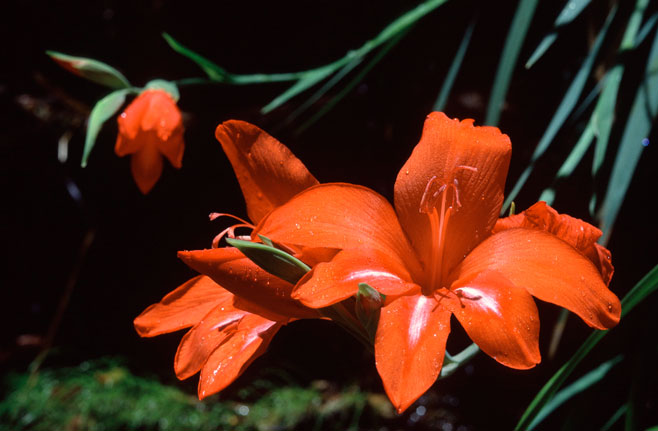|
Gladiolus cardinalis (New Year lily, Waterfall
gladiolus)
Newejaarlelie [Afrikaans] Life
> eukaryotes >
Archaeoplastida >
Chloroplastida
>
Charophyta > Streptophytina > Plantae (land plants)
> Tracheophyta (vascular plants) > Euphyllophyta > Lignophyta (woody plants)
> Spermatophyta (seed plants) > Angiospermae (flowering
plants) > Monocotyledons > Order: Asparagales
> Family: Iridaceae > Genus:
Gladiolus
|
|
 |
 |
|
|
|
A waterfall with Gladiolus cardinalis,
flowering in mid summer in Bavianskloof in the Bain's Kloof mountains,
Western Cape, South Africa. [photo
Colin Paterson-Jones ©] |
Gladiolus cardinalis flowering in
mid-summer next to a waterfall in the Bobbejaansrivier Kloof in the
Bain's Kloof Mountains, Western Cape, South Africa. [photo
Colin Paterson-Jones ©] |
|
 |
|
Gladiolus cardinalis flowering in a
waterfall in summer in the Du Toits Kloof mountains, Western Cape, South
Africa. [photo
Colin Paterson-Jones ©] |
Information is from Goldblatt and Manning (1998).
Distribution and habitat
Endemic to the Western Cape, South Africa, where it occurs
next to waterfalls and on wet cliffs in the mountains from Bain's Kloof to the
Riviersonderend Mountains.
Life cycle
- A geophyte, with corms 12-18 mm wide. These tend to be wedged in
crevices of rock on wet cliffs where the roots are kept constantly wet.
- Flower from mid-December to mid-January, hence its common name, New
Year's lily.
- Seeds are ovate to oblong, measuring 6-8 mm long by 3.5-4 mm wide, with
wings evenly develop or reduced at the sides.
Ecological interactions
Pollinator
- Flowers are pollinated by the butterfly Aeropetes tulbaghia
(Table Mountain beauty).
Publications
- Goldblatt P. and Manning J. 1998. Gladiolus in Southern Africa.
Fernwood Press, Vlaeberg, Cape Town.
Text by Hamish Robertson |
